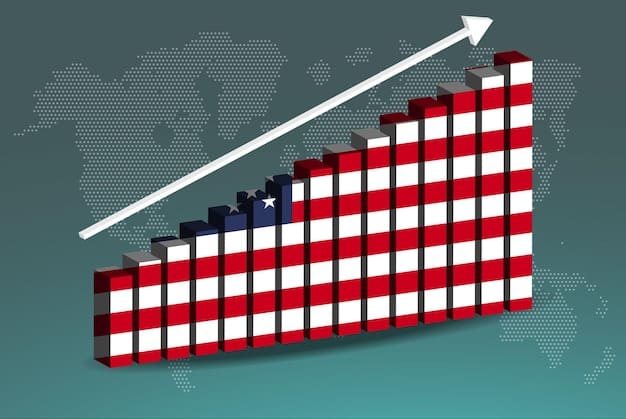Immigration Reform 2025: Impact on US Labor Shortages

The proposed 2025 immigration reform in the US is expected to significantly influence labor shortages across various sectors by altering the availability of foreign workers and potentially reshaping workforce demographics.
The US labor market has faced significant challenges in recent years, with shortages in various sectors. The proposed 2025 immigration reform aims to address these issues, but how exactly will it impact the availability of workers? Let’s delve into the potential effects of this reform on how will the proposed 2025 immigration reform impact US labor shortages.
Understanding the Current US Labor Shortages
The United States has been grappling with widespread labor shortages in recent years. These shortages affect numerous industries, from agriculture and hospitality to healthcare and technology. Understanding the root causes and the extent of these shortages is crucial for assessing the potential impact of any immigration reform.
Key Sectors Affected by Labor Shortages
Several sectors have been particularly hard-hit by labor shortages. The construction industry, for example, struggles to find skilled tradespeople, while the healthcare sector faces a deficit of nurses and other medical professionals. In the agricultural sector, a lack of farmworkers has led to significant challenges in harvesting crops.
Root Causes of Labor Shortages
The reasons behind these shortages are multifaceted. An aging workforce, declining birth rates, and a lack of skilled workers in certain fields all contribute to the issue. Additionally, changes in immigration policies and decreased labor force participation rates have exacerbated the problem.
- Aging Workforce: As baby boomers retire, they are not always replaced by younger workers.
- Skills Gap: Many open positions require specific skills that are not readily available among the current workforce.
- Immigration Policies: Restrictive immigration policies can limit the number of foreign workers available to fill essential roles.
- Low Labor Force Participation: Some individuals have left the labor force due to factors like childcare costs and early retirement.
Addressing these labor shortages requires a comprehensive approach that includes investing in workforce development, reforming immigration policies, and addressing the underlying factors that discourage labor force participation. Understanding these dynamics is the first step toward crafting effective solutions.

Key Proposals of the 2025 Immigration Reform
The proposed 2025 immigration reform includes several critical provisions that could significantly impact the US labor market. These proposals aim to modernize the immigration system, address labor shortages, and promote economic growth. Let’s examine some of the key elements of this reform.
Changes to Visa Programs
One of the central components of the reform is an overhaul of existing visa programs. The proposal seeks to expand the H-1B visa program for skilled workers, increase the number of green cards available for employment-based immigration, and create new visa categories for essential workers in high-demand sectors.
Pathways to Legalization
The reform also includes provisions for providing pathways to legal status for undocumented immigrants currently living in the United States. This could involve creating a system for undocumented workers to earn legal status through employment and meeting certain requirements.
Border Security Measures
In addition to addressing labor shortages, the immigration reform aims to enhance border security measures. This may involve increased funding for border patrol, the deployment of advanced technology, and efforts to streamline the asylum process.
- Expanded H-1B Visas: Increase the number of visas available for skilled workers in technology and other specialized fields.
- Employment-Based Green Cards: Offer more green cards to immigrants with job offers from US employers.
- Essential Worker Visas: Create a new visa category for workers in high-demand sectors like healthcare and agriculture.
These proposals represent a significant effort to address the challenges and opportunities presented by immigration in the 21st century. The impact of these reforms on the US labor market will depend on how effectively they are implemented and how well they align with the needs of employers and workers.
Potential Positive Impacts on Labor Shortages
The proposed 2025 immigration reform could bring several positive impacts on the US labor market by alleviating critical labor shortages. By expanding visa programs and creating pathways to legalization, the reform aims to inject much-needed talent and manpower into key sectors of the economy.
Filling Critical Skill Gaps
One of the most significant benefits of the reform is its potential to fill critical skill gaps in industries like technology, healthcare, and engineering. By making it easier for skilled foreign workers to obtain visas and green cards, the United States can attract top talent from around the world.
Boosting Economic Growth
Increased immigration can also contribute to economic growth by expanding the labor force, increasing productivity, and stimulating innovation. Immigrants often bring new ideas, entrepreneurial spirit, and a willingness to take risks, which can drive economic dynamism.
Supporting Aging Industries
Sectors facing an aging workforce, such as agriculture and construction, could particularly benefit from an influx of younger immigrant workers. These industries often rely on manual labor and are in dire need of individuals willing to perform these tasks.

Expanding visa programs, streamlining the legalization process, and targeted recruitment efforts can ensure that the US labor market remains competitive and responsive to the evolving needs of the economy. The positive impacts of immigration reform could extend far beyond simply filling job vacancies, contributing to long-term economic prosperity and innovation.
Potential Challenges and Concerns
Despite the potential benefits, the proposed 2025 immigration reform also raises several challenges and concerns that need to be addressed. These include the potential for wage depression, the impact on domestic workers, and the strain on social services.
Wage Depression
One concern is that an influx of foreign workers could lead to wage depression in certain sectors. If employers have access to a larger pool of workers, they may be able to lower wages, which could negatively affect domestic workers.
Impact on Domestic Workers
Some worry that immigration reform could displace domestic workers, particularly those with lower skills. If employers prioritize hiring foreign workers over domestic workers, it could lead to increased unemployment among certain segments of the population.
Strain on Social Services
Increased immigration could also place a strain on social services, such as schools, healthcare, and housing. Ensuring that these services are adequately funded and equipped to handle an increased demand is crucial for successful immigration reform.
- Wage Stagnation: Ensuring that increased immigration does not lead to wage stagnation or decline for domestic workers.
- Job Displacement: Addressing concerns about job displacement and providing support for domestic workers who may be affected.
- Resource Allocation: Ensuring that social services are adequately funded and equipped to handle an influx of new immigrants.
Industry-Specific Impacts of Immigration Reform
The 2025 immigration reform is poised to impact various industries in distinct ways, reflecting their unique labor needs and skill requirements. Analyzing these industry-specific effects can provide a clearer understanding of the reform’s potential outcomes.
Technology Sector
The technology sector is highly dependent on skilled foreign workers, particularly in areas like software engineering, data science, and artificial intelligence. An expansion of the H-1B visa program could greatly benefit this sector by allowing companies to hire top talent from around the world. However, compliance with wage standards and fair labor practices is vital to avoid wage depression for domestic tech workers.
Healthcare Sector
The healthcare sector faces severe shortages of nurses, doctors, and other medical professionals. By creating new visa categories for essential workers, the immigration reform could help alleviate these shortages and improve the quality of care. Streamlining the process for foreign-trained healthcare workers to get licensed and practice in the U.S. could further enhance the sector’s capacity to meet patient needs.
Agricultural Sector
Agriculture is another sector that heavily relies on immigrant labor, particularly for seasonal harvesting and farm work. The immigration reform could provide a pathway to legalization for undocumented farmworkers, ensuring a stable and reliable workforce. Implementing labor protections and fair wage standards is essential to improve working conditions and reduce exploitation in this sector.
Each sector may face unique challenges and opportunities, but carefully designed immigration policies can play a crucial role in supporting innovation, growth, and productivity across the economy.
Alternative Solutions to Address Labor Shortages
While immigration reform is one approach to addressing labor shortages, it is not the only solution. There are several alternative strategies that policymakers and employers can pursue to alleviate workforce challenges. These include investing in workforce development, increasing automation, and improving working conditions.
Investing in Workforce Development
One of the most sustainable ways to address labor shortages is to invest in workforce development programs. These programs can provide individuals with the skills and training they need to fill open positions in high-demand sectors.
Increasing Automation
Automation can also help alleviate labor shortages by allowing companies to do more with fewer workers. By investing in new technologies, companies can increase productivity and reduce their reliance on manual labor.
Improving Working Conditions
Improving working conditions is another way to attract and retain workers. By offering better wages, benefits, and work-life balance, employers can make themselves more attractive to potential employees.
A combination of these strategies is likely to be the most effective approach to addressing labor shortages in the United States. While immigration reform can play a role, it is important to consider all available options and to implement policies that promote long-term economic growth and stability.
| Key Point | Brief Description |
|---|---|
| 🔑 Visa Program Changes | Expansion of H-1B visas for skilled workers and new visas for essential workers. |
| 💼 Pathways to Legalization | Opportunities for undocumented immigrants to earn legal status through employment. |
| 📈 Economic Growth | Increased immigration boosting overall economic activity and productivity. |
| 🛡️ Border Security | Enhanced measures to secure the border and streamline the asylum process. |
Frequently Asked Questions
▼
The primary goals include addressing labor shortages, modernizing the immigration system, providing pathways to legal status for undocumented immigrants, and enhancing border security measures.
▼
The expansion of the H-1B visa program could greatly benefit the tech sector by allowing companies to hire skilled workers from around the world, filling critical skill gaps.
▼
An influx of foreign workers could potentially lead to wage depression in certain sectors, impacting domestic workers if employers have access to a larger pool of workers.
▼
Alternative solutions include investing in workforce development, increasing automation, and improving working conditions to attract and retain a larger pool of domestic workers.
▼
By creating new visa categories for essential workers, the immigration reform could help alleviate critical shortages of nurses, doctors, and other medical professionals, improving healthcare.
Conclusion
The proposed 2025 immigration reform presents both opportunities and challenges for the US labor market. While it could help alleviate labor shortages and boost economic growth, it is important to address potential concerns such as wage depression and the strain on social services. A comprehensive approach that combines immigration reform with investments in workforce development and other strategies is essential for ensuring a strong and stable labor market.





